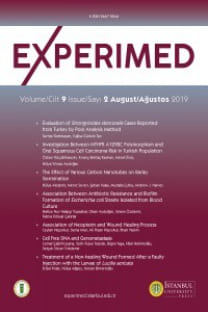The Comparative Molecular Typing of Haemophilus Influenzae Strains Isolated from the Adenoid and Tonsils in Patients Undergoing Adenotonsillectomy
The Comparative Molecular Typing of Haemophilus Influenzae Strains Isolated from the Adenoid and Tonsils in Patients Undergoing Adenotonsillectomy
___
- 1. Doğu F. Tonsil ve adenoidlerin immunobiyolojisi. J Ankara Univ Fac Med 2002; 55(4) :291-6. [CrossRef] google scholar
- 2. Gross CW, Harrison SE. Tonsils and adenoids. Pediatr Rev 2000; 21(3): 75-8. [CrossRef] google scholar
- 3. Zalzal GH, Cotton RA. Otolaryngology. In: Cummings CW, Fredrickson MF, Harker LA, editors. Head and Neck Surgery. St. Louis: Toronto; 1986. p.1189-211. google scholar
- 4. Bailey BJ, Johnson JT, Newlands SD. Head & neck surgeryotolaryngology: Lippincott Williams & Wilkins; 2006. google scholar
- 5. Özerol I, Aşgın N, Kalicioğlu M. Üst solunum yolu infeksiyonlarında Moraxella catarrhalis’in önemi. J Inonu Univ Fac Med 2002; 9(1): 25-7. google scholar
- 6. Nakipoglu Y, Gunel G, Kanliada D, Aydemir L, Gurler N, Gurler B. An investigation of the frequency of upper respiratory tract infection pathogens and their antibiotic patterns in tonsils and adenoids of adenotonsillectomy patients. Clin Lab 2016; 62: 1547-52. [CrossRef] google scholar
- 7. Giufrè M, Cardines R, Accogli M, Pardini M, Cerquetti M. Identification of Haemophilus influenzae clones associated with invasive disease a decade after introduction of H. influenzae serotype b vaccination in Italy. Clin Vaccine Immunol 2013; 20(8): 1223-9. [CrossRef] google scholar
- 8. Barbosa AR, Giufre M, Cerquetti M, Bajanca-Lavado MP. Polymorphism in FtsI gene and ß-lactam susceptibility in Portuguese Haemophilus influenzae strains: Clonal dissemination of ß-lactamase-positive isolates with decreased susceptibility to amoxicillin/clavulanic acid. J Antimicrob Chemoth 2011; 66(4): 788-96. [CrossRef] google scholar
- 9. Tenover FC, Arbeit RD, Goering RV, Mickelsen PA, Murray BE, Persing DH, et al. Interpreting chromosomal DNA restriction patterns produced by pulsed-field gel electrophoresis: criteria for bacterial strain typing. J Clin Microbiol 1995; 33(9): 2233-9. [CrossRef] google scholar
- 10. Choi DH, Park J, Choi JK, Lee KE, Lee WH, Yang J, et al. Association between the microbiomes of tonsil and saliva samples isolated from pediatric patients subjected to tonsillectomy for the treatment of tonsillar hyperplasia. Exp Mol Med 2020; 52(9): 156473. [CrossRef] google scholar
- 11. Oliveira Branco AA, Castro Correa C, Souza Neves D, Huehara T, Theresa Weber SA. Swallowing patterns after adenotonsillectomy in children. Pediatr Investigation 2019; 3(3): 153-8. [CrossRef] google scholar
- 12. Fuji N, Pichichero M, Kaur R. Haemophilus influenzae prevalence, proportion of capsulated strains and antibiotic susceptibility during colonization and acute otitis media in children, 2019-2020. Pediatr Infect Dis J 2021; 27; 40(9): 792-6. [CrossRef] google scholar
- 13. Galli J, Calò L, Posteraro B, Rossi G, Sterbini FP, Paludetti G, et al. Pediatric oropharyngeal microbiome: Mapping in chronic tonsillitis and tonsillar hypertrophy. Int J Pediatr Otorhinolaryngol 2020; 139: 110478. [CrossRef] google scholar
- 14. Jensen A, Fagö-Olsen H, S0rensen CH, Kilian M. Molecular mapping to species level of the tonsillar crypt microbiota associated with health and recurrent tonsillitis. PloS One 2013; 8(2): e56418. [CrossRef] google scholar
- 15. Chekrouni N, Koelman DLH, Brouwer MC, van der Ende A, van de Beek D. Community-acquired Haemophilus influenzae meningitis in adults. J Infect 2021; 82(5): 145-50. [CrossRef] google scholar
- 16. Öncül O, Özsoy FM, İnci E, Pahsa A. Rekürren akut tonsillit olgularında tonsil yüzey, çekirdek ve arka yüz mikroflorasının karşılaştırılması. Flora 2001; 6: 101-7. google scholar
- 17. Ünal A, Küçükoğlu S, Aslan A, Işılak I, Nalça Y. Kronik rekürren tonsillit olgularında yüzeyel ve derin tonsil florası. KBB ve BBC Derg 1998; 6: 33-6. google scholar
- 18. Hadi U, El-Hajj M, Uwaydah M, Fuleihan N, Matar GM. Characteristics of pathogens recovered from the tonsils and adenoids in a group of Lebanese children undergoing tonsillectomy and adenoidectomy. J Appl Res 2005; 5(3); 473-80. google scholar
- Yayın Aralığı: Yılda 3 Sayı
- Başlangıç: 2011
- Yayıncı: İstanbul Üniversitesi
Investigation of Galectin-3 Levels of Endometriosis Patients According to Stages
D. Fulya KIZILGEDİK, Armagan CANER, Çağlar YILDIZ, Buğra OKŞAŞOĞLU, Sema MISIR, İlhan YAYLIM, Semra DEMOKAN, Ceylan HEPOKUR
Impact of Anogenital Distance Parameters on Female Sexual Dysfunction
A Bioinformatics Analysis of circRNA/miRNA/mRNA Interactions in Acute Myeloid Leukemia
Cihat ERDOĞAN, Murat KAYA, Ilknur SUER
Ceren ÖZBEK, Revan Birke KOCA-ÜNSAL, Merva SOLUK TEKKEŞİN, Faruk ÇELİK, Hayriye Arzu ERGEN, Ümit ZEYBEK, Kıvanç BEKTAŞ KAYHAN, Meral ÜNÜR
Delta Secretase and BDNF Signalling in Alzheimer’s Disease
Buse ÜNLÜ, Sümeyra ILDIZ, Duygun GEZEN AK, Erdinç DURSUN
Esra AYDEMİR, Derya BURUKCU, Gürcan VURAL, Taner KIVILCIM, Fikrettin ŞAHİN
Mustafa Gani SÜRMEN, Tijen ALKAN BOZKAYA, Şanser ATEŞ, Saime SÜRMEN, Çağrı ÇAKICI, Sadrettin PENÇE, Neslin EMEKLİ
Association of EGFR Gene Polymorphism with Glioma Susceptibility in Turkish Population
Gozde OZCAN, Fatma Tuba AKDENİZ, Seda GÜLEÇ, Zerrin BARUT, Deryanaz BİLLUR, Turgay İSBİR, Cumhur Kaan YALTIRIK
Gülşen GÜNEL, Levent AYDEMİR, Özlem ÜNALDI, Yasar NAKİPOĞLU
An in silico Investigation of Anticancer Peptide Candidates in Fermented Food Microbiomes
